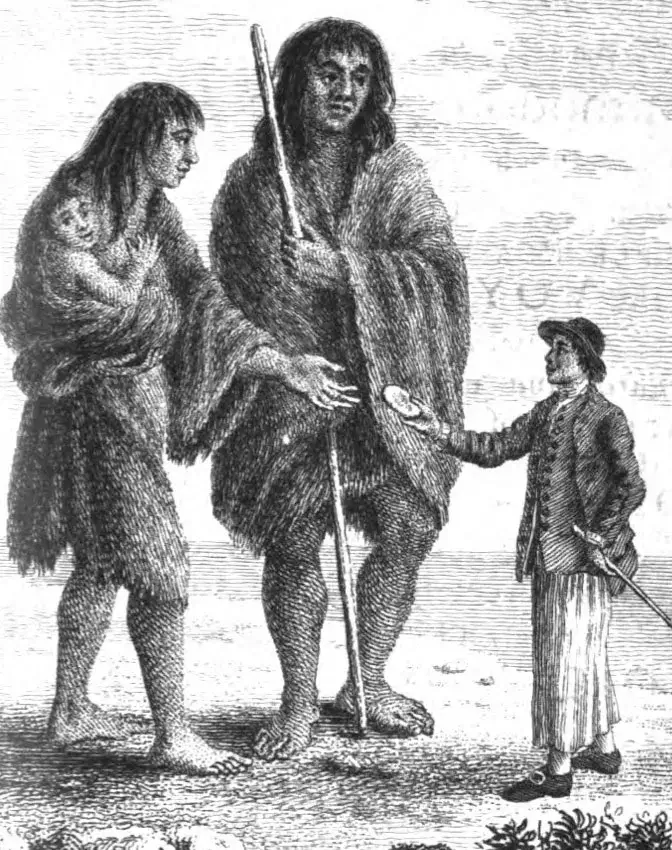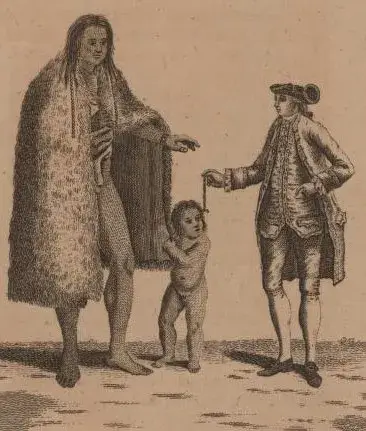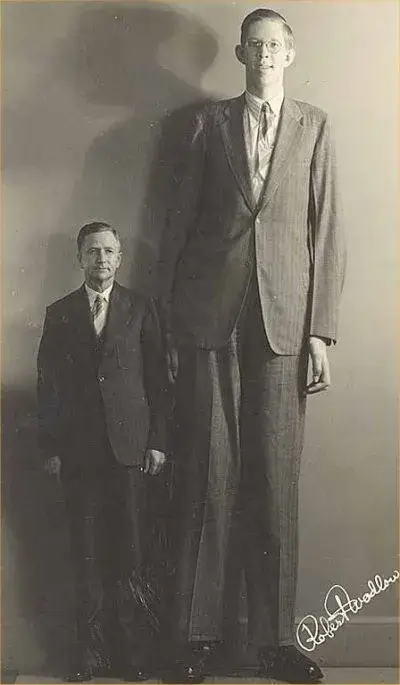
Magellan’s Strange Encounter With The 10-Foot Giants of Patagonia
In 1520, Ferdinand Magellan took time out of his busy schedule of sailing around the world to stop in what is now Patagonia, where he found a naked giant dancing and singing on the shore. Magellan ordered one of his men to make contact (the unwitting emissary’s no doubt hilarious reaction to this sadly has been lost to history), and to be sure to reciprocate the dancing and singing to demonstrate friendship.
By: Matt Simon | Wired

IN 1520, FERDINAND Magellan took time out of his busy schedule of sailing around the world to stop in what is now Patagonia, where he found a naked giant dancing and singing on the shore. Magellan ordered one of his men to make contact (the unwitting emissary’s no doubt hilarious reaction to this sadly has been lost to history), and to be sure to reciprocate the dancing and singing to demonstrate friendship.
It worked. The man was able to lead the giant to a small island offshore, where the great captain waited. Describing the scene was a scholar along for the journey, Antonio Pigafetta, who kept a diary of the journey that was later turned into the book Magellan’s Voyage: A Narrative Account of the First Circumnavigation: “When he was before us, he began to marvel and to be afraid, and he raised one finger upward, believing that we came from heaven. And he was so tall that the tallest of us only came up to his waist,” and had a big, booming voice. The illustration above proves it—Patagonia was once inhabited by giants that positively dwarfed the heavenly Europeans that would come to conquer them.
Alright, maybe that isn’t airtight evidence. But it could well be that the people Magellan encountered, the Tehuelche, were indeed enormous, and that therefore this myth has some grounding in reality. And our trusty explorer would be damned if he wasn’t going to try to bring back evidence in pretty much the most obnoxious way you could imagine.

On that small island, Magellan had his men give the giant food and drink, then made the mistake of showing him a mirror. “Wherein the giant seeing himself was greatly terrified,” wrote Pigafetta, “leaping back so that he threw four of our men to the ground.” But once things had calmed down, the explorers proceeded to make contact with the rest of the tribe, hunting with them and even building a house to store their provisions while onshore.
After several weeks with the tribe, Magellan hit upon a scheme: He’d kidnap two of them and take them back to Spain to prove he had discovered giants. “But this was by a cunning trick, for otherwise [the giants] would have troubled some of our men.” Magellan gave them all manner of metal goods to fool around with—mirrors, scissors, bells—so they wouldn’t mind at all when he slapped cuffs and chains on their legs. “Whereat these giants took great pleasure in seeing these fetters, and did not know where they had to be put, and they were grieved that they could not take them in their hands” because their mitts already were full of other trinkets.
Magellan, though, lost his evidence during the long haul back to Spain. The giants didn’t survive. But what Magellan and Pigafetta did bring back was the tale and the new name of the land of the giants, Patagonia, the etymology of which is still unclear. Some have argued it means “Land of the Big Feet,” from “pata,” Spanish for foot. More likely, though, Magellan picked up the name from a popular novel at the time, Primaleon, which featured a race of wild people called the Patagonians.

But leave it to the Brits to throw cold water on the whole thing. Sir Francis Drake later made contact with the same Patagonians, as summarized by his nephew in The World Encompassed from 1628 (a smack down worth quoting at length):
“Magellan was not altogether deceived in naming these giants, for they generally differ from the common sort of man both in stature, bigness and strength of body, as also in the hideousness of their voices: but they are nothing so monstrous and giant-like as they were represented, there being some English men as tall as the highest we could see, but peradventure the Spaniards did not think that ever any English man would come hither to reprove them, and therefore might presume the more boldly to lie.”
You may have noticed by now that most illustrations of the Patagonian giants involve Europeans handing them things. It was the map above that likely influenced them, including this drawing of Commodore John Byron conversing with a Patagonian woman.

That, as scholars put it, is a sick burn. It’s also entirely right. According to William C. Sturtevant in his essay “Patagonian Giants and Baroness Hyde de Neuville’s Iroquois Drawings,” the Tehuelche were just a particularly statuesque people. While subsequent voyages after Magellan’s measured the Patagonians up to 10 feet tall, others put them more in the 6-foot range.
“Popular interest in Patagonian giants waned as scientific reports began to appear,” writes Sturtevant. “Some 19th century estimates or measurements of individuals were still high,” upwards of 7 feet. But better samples of Tehuelche men brought them down to around 6 feet tall, perfectly reasonable for a human being but entirely unimpressive for a giant. “If we accept the lowest (and least well documented) of these means based on modern measurements of males series,” he adds, “the Tehuelche are nevertheless among the tallest populations known anywhere in the world.” By contrast, male Europeans like Magellan in the 16th through 18th centuries would have measured in the low-5-foot range. Their imaginations, though, apparently outgrew their small stature.
But why, then, do human beings vary so much in their height? There is of course the factor of nutrition, but a much more subtle influence is at work here.
The tallest man who ever lived, Robert Wadlow, with his father, who appears grumpy probably because of all the money he had to spend on his son’s giant clothes.

Animals, including humans, have a tendency to grow larger in cold climates and smaller in warm ones. This is known as Bergmann’s rule: With a big body, you lose heat less quickly, and are therefore better adapted to survive freezing temperatures. So it’s no accident that the world’s biggest terrestrial predator, the polar bear, takes to the far north, while tropical creatures, which can shed heat quicker, are better adapted to sweltering jungles. And over evolutionary time, environments can exert the same pressure on human beings. Thus would the natives of frigid Patagonia do well to grow larger than their European counterparts?
There’s also the possibility that the Tehuelche man who Magellan and his crew claimed was so tall they only reached his waist suffered from a disorder of the pituitary gland. This releases runaway levels of the human growth hormone, as it did in the tallest man in recorded history, the 8-foot-11 Robert Wadlow. Indeed, the photograph above shows Robert and his 5-foot-11 father—a man far taller than the average male in the 1500s—coming up to his son’s waist.
The human body, though, is simply not meant to grow to such heights. Pituitary giants typically have much shorter life spans than the average human because their hearts, even though proportionally enlarged, struggle to pump blood through their bodies. Wadlow himself had little sensation in his feet, eventually dying at just 22 from an infected blister that he never felt forming.
So even if it were possible to have an entire race of such giants, it would be a very unhealthy population indeed. Thus the giants of Patagonia remain nothing more than products of some sailors’ imaginations—and maybe a little bit of scurvy. Never hurts to blame scurvy.
* * *
NEXT UP!
Giant “Skeletons of Enormous Size” Discovered In New Mexico – New York Times Article From 1902
Researcher Graham Hancock coined the phrase, ‘we’re like a species with amnesia,’ and it’s true. Despite the fact that it seems the story of human history is well uncovered, every single year there are new discoveries made that challenge what we once held to be true. In some cases, there are discoveries which are concealed from the general public for various reasons, a great example of that would be the black budget world.
* * *
READ MORE: Ex-Pentagon Scientist, Vallée & FBI Report Suggest Interdimensional Beings Exist Among Us
Read more on The Nephilim: Satellite: Nephilim Giant Caught on Satellite Imagery of the Patagonian Mountains (Video)
Telegram: Stay connected and get the latest updates by following us on Telegram!
We’d love to hear from you! If you have a comment about this article or if you have a tip for a future Collective Spark Story please let us know below in the comment section.
